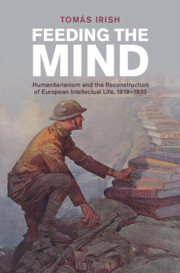Refine search
Actions for selected content:
105 results
Chapter 3 - Darkening Skies, 1830–1850
-
- Book:
- Irish Romanticism
- Published online:
- 27 November 2025
- Print publication:
- 11 December 2025, pp 116-163
-
- Chapter
- Export citation
Introduction
-
-
- Book:
- Hunger Redraws the Map
- Published online:
- 01 November 2025
- Print publication:
- 20 November 2025, pp 1-17
-
- Chapter
- Export citation
11 - The Science of Hunger and Malnutrition
-
-
- Book:
- Hunger Redraws the Map
- Published online:
- 01 November 2025
- Print publication:
- 20 November 2025, pp 319-339
-
- Chapter
- Export citation
7 - Hunger in Urban and Rural Areas, and Children on the Move
-
-
- Book:
- Hunger Redraws the Map
- Published online:
- 01 November 2025
- Print publication:
- 20 November 2025, pp 197-230
-
- Chapter
- Export citation
4 - Individual Strategies of Survival
-
-
- Book:
- Hunger Redraws the Map
- Published online:
- 01 November 2025
- Print publication:
- 20 November 2025, pp 115-143
-
- Chapter
- Export citation

Hunger Redraws the Map
- Food, State, and Society in the Era of the First World War
-
- Published online:
- 01 November 2025
- Print publication:
- 20 November 2025
5 - The Three-Way Tussle for Food
-
- Book:
- Grains of Conflict
- Published online:
- 23 August 2025
- Print publication:
- 31 July 2025, pp 184-224
-
- Chapter
- Export citation
Dietary protein, muscle and the fat-free mass within the Protein-Stat control framework: Blaxter Award Lecture 2025
-
- Journal:
- Proceedings of the Nutrition Society , First View
- Published online by Cambridge University Press:
- 04 July 2025, pp. 1-19
-
- Article
-
- You have access
- Open access
- HTML
- Export citation
8 - Jewish Experiences of Segregation and Ghettoization
-
-
- Book:
- The Cambridge History of the Holocaust
- Published online:
- 16 May 2025
- Print publication:
- 12 June 2025, pp 132-146
-
- Chapter
- Export citation
When the Storm of Chieftaincy Conflict Settles: What Happens to Food Security?
-
- Journal:
- International Annals of Criminology / Volume 63 / Issue 2 / June 2025
- Published online by Cambridge University Press:
- 23 June 2025, pp. 215-232
- Print publication:
- June 2025
-
- Article
-
- You have access
- HTML
- Export citation
Hunger and the gender gap
-
- Journal:
- Experimental Economics / Volume 22 / Issue 4 / December 2019
- Published online by Cambridge University Press:
- 14 March 2025, pp. 885-917
-
- Article
- Export citation
New Mexico’s aggressive plan to end child food insecurity and hunger through universal school meals policy adoption
-
- Journal:
- Public Health Nutrition / Volume 28 / Issue 1 / 2025
- Published online by Cambridge University Press:
- 09 January 2025, e32
-
- Article
-
- You have access
- Open access
- HTML
- Export citation
9 - Unequal Encounters
- from Part III - Governance, Politics, and Self-Determination
-
-
- Book:
- Empire, Colonialism, and the Human Sciences
- Published online:
- 24 October 2024
- Print publication:
- 07 November 2024, pp 237-260
-
- Chapter
-
- You have access
- Open access
- HTML
- Export citation
Plant protein, fibre and physical activity solutions to address poor appetite and prevent undernutrition in older adults: study protocol for the APPETITE randomised controlled trial
-
- Journal:
- British Journal of Nutrition / Volume 132 / Issue 6 / 28 September 2024
- Published online by Cambridge University Press:
- 10 October 2024, pp. 823-834
- Print publication:
- 28 September 2024
-
- Article
-
- You have access
- Open access
- HTML
- Export citation
Post-growth agrifood systems: Towards an emancipatory politics
-
- Journal:
- Review of International Studies / Volume 50 / Issue 5 / September 2024
- Published online by Cambridge University Press:
- 30 September 2024, pp. 898-909
- Print publication:
- September 2024
-
- Article
-
- You have access
- Open access
- HTML
- Export citation
Chapter 5: - Intuitive Eating
-
- Book:
- Adultish
- Published online:
- 10 October 2024
- Print publication:
- 01 August 2024, pp 75-94
-
- Chapter
- Export citation
4 - Black Markets, Green Expeditions
-
- Book:
- Streetscapes of War and Revolution
- Published online:
- 30 May 2024
- Print publication:
- 06 June 2024, pp 156-206
-
- Chapter
-
- You have access
- Open access
- HTML
- Export citation
Food Shortages during the Post-Habsburg Transition in the Bohemian Lands and Slovenia
-
- Journal:
- Austrian History Yearbook / Volume 55 / May 2024
- Published online by Cambridge University Press:
- 08 March 2024, pp. 243-253
- Print publication:
- May 2024
-
- Article
-
- You have access
- Open access
- HTML
- Export citation
Chapter 7 - Session 2: The Eats
- from Part II - A Session-by-Session Guide to Feeling and Body Investigators
-
- Book:
- Treating Functional Abdominal Pain in Children
- Published online:
- 18 November 2023
- Print publication:
- 30 November 2023, pp 54-65
-
- Chapter
- Export citation

Feeding the Mind
- Humanitarianism and the Reconstruction of European Intellectual Life, 1919–1933
-
- Published online:
- 07 October 2023
- Print publication:
- 05 October 2023
